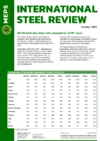Will UK exemption begin ‘erosion’ of US steel tariffs?
The United Kingdom’s trade deal with the United States could mark the start of an erosion of Section 232 import tariffs and US steel prices.
US President Donald Trump and UK Prime Minister Sir Kier Starmer gave insight into a trade deal which would remove the 25% tariff on UK steel in a media conference yesterday (May 8). It would also reduce the tariff rate on UK-built cars from 25% to 10% for 100,000 units per year, after which a 27.5% tariff would be applied. Rolls-Royce jet engines will also be tariff-free.
President Trump said that, in return, the UK would remove its tariffs on US beef, ethanol, sports equipment and other products and would also buy USD10 billion of Boeing aeroplanes under the agreement.
It has taken over 50 days, since President Trump applied 25% import tariffs on steel, aluminium and automotive imports, for a deal to be announced between the US and one of its closest allies. Details of the US-UK trade deal, which remains subject to further negotiation, are limited, however.
Reducing Section 232’s ‘effectiveness’
Nonetheless, MEPS International US steel market analyst, Laura Hodges, said that the deal could mark the start of a series of trade agreements that reduce the effect of tariffs on US steel prices.
“The effectiveness of Section 232 steel tariffs is being chipped away again with the UK trade deal,” said Hodges.
“Reportedly the UK and US will now have a 0% tariff on their bilateral steel trade. This is the beginning of the exemptions that eroded Section 232 tariffs in 2018/2019.”
She added: “US steel prices are significantly higher than the rest of the world and are currently elevated only due to the tariff. If the tariff erodes, so do our prices in the near-term.
“We already expected prices to pull back this summer because of lower-than-expected demand from US manufacturing and construction. While more details are needed, the new deal places a downside risk to our near-term price outlook.”
MEPS’s US hot rolled coil prices rose by almost 40% in quarter one. Domestic producers increased their steel prices amid an expectation of tightening supply. Importers, meanwhile, accelerated procurement in an effort to beat the incoming import tariffs.
In MEPS's recent US-focussed Market in Minutes podcast episode, Hodges said that steel imports into the US had not declined since the reintroduction of 25% Section 232 tariffs. Importers are sourcing low-cost material from non-traditional sources, however, after the tariffs’ blanket implementation effectively “levelled the playing field” between steel-producing countries, she said.
The recent rise in steel prices has also stalled. Research conducted for MEPS’s International Steel Review showed that subdued demand, and tariff uncertainty, has contributed to the market slowdown.
Forming a US-UK steel trade union
Some steel market participants are disappointed that trade deals with the US’s North American trading partners, Canada and Mexico, were not prioritised by the Trump administration. US buyers sourced 240,395 tonnes of the US’s 26.2m tonnes of steel imports from the UK in 2024.
White House documents suggest that the US-UK deal will be underpinned by a new agreement on trade defence measures to tackle global steel overcapacity. They state that “the United States also recognizes the economic security measures taken by the UK to combat global steel excess capacity,” adding that “this deal creates a new trading union for steel and aluminum.”
The UK’s Trade Remedies Authority is currently investigating revisions to its steel import safeguard measures. In line with EU safeguard measures, the country will be implementing a new trade defence framework when its current model expires in June 2026.

Source:
International Steel Review
The MEPS International Steel Review is an essential monthly publication, offering professional analysis and insight into carbon steel prices around the world.
Go to productRequest a free publication





